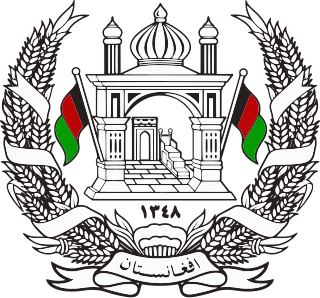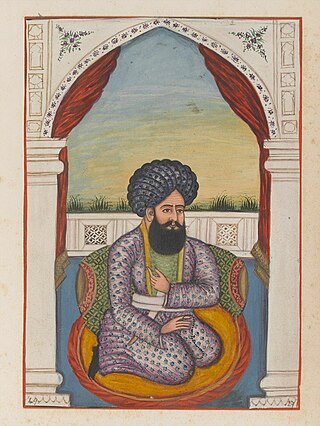Related Research Articles

Sayyid is an honorific title of Hasanids and Husaynids Muslims, recognized as descendants of the Islamic prophet's companion, Ali through his sons, Hasan and Husayn.

The Qadiriyya or the Qadiri order is a Sufi mystic order (tariqa) founded by Sheikh Abdul Qadir Gilani, who was a Hanbali scholar from Gilan, Iran. The order relies strongly upon adherence to the fundamentals of Sunni Islamic law.

Khawajah Syed Qutbuddin Maudood Chishti was an early day Sufi Saint, a successor to his father and master Abu Yusuf Bin Saamaan, twelfth link in the Sufi silsilah of Chishti Order, and the Master of Shareef Zandani. He was born around 430 Hijri in the city of Chisht. He initially received education from his father. He memorized the Qur'an by age 7 and completed his education when he was 16. His work includes two books, Minhaaj ul Arifeen and Khulaasat ul Shariah. He died in the month of Rajab at the age of 97 in 533 AH. He was buried at Chisht like many of the early Chishtiyya.

The Barakzai dynasty, also known as the Muhammadzai dynasty, ruled what is now Afghanistan from 1823 to 1978, when the monarchy ended de jure under Musahiban Mohammad Zahir Shah and de facto under his cousin Sardar Mohammad Daoud Khan. The Barakzai dynasty was established by Dost Mohammad Khan after the Durrani dynasty of Ahmad Shah Durrani was removed from power. As the Pahlavi era in Iran, the Muhammadzai era was known for its progressivist modernity, practice of Sufism, peaceful security and neutrality, in which Afghanistan was referred to as the "Switzerland of Asia".

The Naqvis are people found predominantly in Iran, Iraq, and the South Asian countries. They claim descent from the Imam.

The Imamiyya-Ridhawiyya-Mahdawiyya-Qadiriyya-Naqshbandiyya-Ishaniyya Line of Succession also known as the Sayyid ul Sadatiyya, is a cognatic Sunni lineage of Naqib al-ashrafs of the family of Muhammad reaching Sayyid Mir Jan and being notable for their relation to the 12th Imam Muhammad ibn Hasan al Mahdi in occultation. It is an Orthodox-Sunni school with a central emphasis on the teachings of the Muslim Saint Sayyid Mir Jan. It is the hereditary line of supreme leadership (Ishaniyat) over the Naqshbandi Sufi Order. The line is also called the Qadiriyya wa Naqshbandiyya hereditary Silsila to Muhammad and representation of the 12th Imam, differing from the Twelver-Shia tradition in honor of their namesake ancestors the Hanbali Imam Sayyid Abdul Qadir Gilani and the Hanafi Scholar Sayyid Bahauddin Naqshband, combining both Sufi Orders.

Ziyarat Naqshband Sahab is a Sunni Muslim shrine, or ziyarat, in Srinagar in Jammu and Kashmir, India. It is one of the traditional Mausoleums of the Hazrat Ishaans, who are descendants of Bahauddin Naqshband and Mughal royals. Besides the Ziyarat Naqshband Sahab in Srinagar, Kashmir, the Hazrat Ishaans have a Ziyarat in Lahore in Begampura.

Ghous Sayyid Mir Jan Shah Saheb ibn Hasan Naqshbandi Ishaani was a Sunni saint from Kabul and contemporary supreme leader of the Naqshbandi Tariqa and Naqshbandi Ishaani Sub-Tariqa as the 7th hereditary successor of his ancestor Hazrat Ishaan.
Naqib al-ashraf was a governmental post in various Muslim empires denoting the head or supervisor of the descendants of the Islamic prophet Muhammad. The descendants of Muhammad were known as ashraf and throughout Islamic history, the ashraf organized themselves into large groups, akin to corporations, throughout the various Muslim territories. This was done to ensure their special place in Muslim society and thus maintain their socio-political privileges.

Hazrat Ishaan Mahmud bin Sharif bin Zia bin Muhammad bin Tajuddin bin Hussein bin Zahra binte Bahauddin Naqshband was an influential Sunni saint from Bukhara, Uzbekistan and hereditary supreme leader of his ancestor Bahauddin Naqshband's Sufi Order, the Naqshbandiyya.

Sultan Mohammad Khan, also known as Ghazi Sardar Sultan Mohammad Talaei, and known by his epithet, Sultan Mohammad Khan the Golden was an Afghan chief minister and regent. He was a powerful brother of Emir Dost Mohammad Khan, the eventual ruler of Afghanistan who seized control of Kabul from him. Prior to and during the reign of Dost Mohammad Khan, Sultan Muhammad Khan Telai was chief minister and governor of various regions of Afghanistan, including Kabul, Peshawar and Kohat. He was the first of the Musahiban, a Mohammadzai dynasty that began with him and ruled Afghanistan for more than 150 years, in various forms such as emir, king or president from 1823 to 1978.

Mir Sayyid Mahmud Agha, officially known as Sayyid ul Sadaat Mir Sayyid Mahmud Saheb Agha ibn Mir Hasan Naqshbandi al-Hasani wal-Husseini was a Sufi saint of South Asia. He was the brother of Sayyid Mir Jan and acted under him as Grand Master of the Naqshbandi Sufi order. Together with his brother, he preached the legacy of their ancestor Hazrat Ishaan.
Ibrāhīm ibn Mūsā al-Kāẓim, known as al-Murtaḍā, died 825 or after 837, was a ninth century Alid leader who led a rebellion against the Abbasid Caliphate in the Yemen in the aftermath of the Fourth Fitna. He later seized control of Mecca in ca. 817, and was subsequently recognized as legal governor of the city by the caliph al-Ma'mun.
Sayyid Ali al-Akbar ibn al-Hasan was a Sunni Muslim saint, and according to some historians of genealogy the second son of Imam Hasan al-Askari, the eleventh Imam in Shia Islam. He was also the brother of the twelfth Imam Muhammad al-Mahdi. His existence was hidden because of contemporary political conflicts with the political leadership of the Abbasids, reaching its peak at that time.

Sayyid ul-Sadaat Sayyid Moinuddin Hadi Naqshband al-Hasani wal-Husseini, known as "Hazrat Naqshband Saheb", was a Sunni Muslim wali (saint) from Bukhara and direct descendant of Muhammad, through his father Hazrat Ishaan who was a seventh generation descendant of Bahauddin Naqshband. Moinuddin Naqshband succeeded his father in leading the Silsile Aliyya Naqshbandiyya.
Sayyid Mir Fazlullah bin Sayyid Mir Hasan Naqshbandi was a Sunni Saint and Mir and the highest Qadi and Grand Mufti of the Emirate of Afghanistan.

Khwaja Sayyid Mir Alauddin ibn Muhammad Attar, was a Sufi Saint from Bukhara and Qutb of the Naqshbandi Sufi order. He was a descendant of Muhammad and son in law of his master and predecessor Khwaja Bahauddin Naqshband.

Sayyid Kastir Gul (1573–1653) was an Islamic jurist and Sufi saint who is revered among Afghans and Pakistanis. He is the patriarch of the Kakakhel tribe.

Abu al Barakat Sayyid Imam Ali Shah (1798-1865) was a senior Indian Sufi Saint. He was of the Qadiri Naqshbandi Sufi Order. He is from Rattar Chhattar a village in Punjab that is called "the noble sanctuary" in his honor. In the Qadiri Naqshbandi Sufi Order he is venerated as the "sustainer of the order in the world".
References
- ↑ Imam Ali ibn al-Hussein (2001). The Complite Edition of the Treatise on Rights. Qum: Ansariyan Publications.
- ↑ Sharif al-Qarashi2, Baqir (2000). The Life Of Imam Musa Bin Ja'far aL-Kazim (PDF). Translated by Jasim al-Rasheed. Iraq: Ansarian
- ↑ Tazkare Khwanadane Hazrat Eshan(genealogy of the family of Hazrat Eshan)(by author and investigator:Muhammad Yasin Qasvari Naqshbandi company:Edara Talimat Naqshbandiyya Lahore) p.65
- ↑ Mir Assadullah Sadat in Khwajagan Naqshband, 8th discourse
- ↑ Tazkare Khwanadane Hazrat Eshan(genealogy of the family of Hazrat Eshan)(by author and investigator:Muhammad Yasin Qasvari Naqshbandi company:Edara Talimat Naqshbandiyya Lahore) p.65
- ↑ Khtame Ziarate Sharife hazrat eshan Bukhari(written and investigated by Mian Ahmad Bader Akhlaq(BSC)) printed the second time in 1988 Writer and inspector Mian Muhammad Hasan Akhlaq (M.Km) 1988 company: Koperatis Lahorin
- ↑ Mir Assadullah Sadat in Khwajagan Naqshband, 8th discourse
- ↑ Mir Assadullah Sadat in Karamat Sahaba 1st discourse
- ↑ Dissent on Core Beliefs: Religious and Secular Perspectives, Cambridge University Press, 2015, p. 142, ISBN 978-1-1071-0152-4
- ↑ Khtame Ziarate Sharife hazrat eshan Bukhari(written and investigated by Mian Ahmad Bader Akhlaq(BSC)) printed the second time in 1988 Writer and inspector Mian Muhammad Hasan Akhlaq (M.Km) 1988 company: Koperatis Lahorin
- ↑ Mir Assadullah Sadat in Khwajagan Naqshband, 8th discourse
- ↑ Tazkare Khwanadane Hazrat Eshan(genealogy of the family of Hazrat Eshan)(by author and investigator:Muhammad Yasin Qasvari Naqshbandi company:Edara Talimat Naqshbandiyya Lahore) p.65
- ↑ Tazkare Khwanadane Hazrat Eshan(genealogy of the family of Hazrat Eshan)(by author and investigator:Muhammad Yasin Qasvari Naqshbandi company:Edara Talimat Naqshbandiyya Lahore) p.65